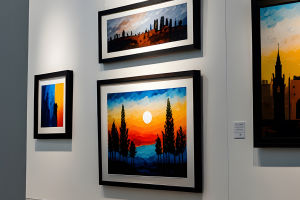Painting on glass offers a rewarding creative experience that combines patience and skill. For all Lykkers interested in exploring this beautiful art form, understanding the right materials and methods is essential for success.
This guide presents the key steps and tips needed to create impressive glass decorations, making the process approachable and enjoyable.
Choosing the Right Colors for Glass Painting
Consider the Environment
Before starting, the painting area should be well-ventilated to ensure safety and proper drying conditions.
Preparing the Glass Surface
Clean the glass thoroughly using dish soap & warm water to remove any grease or dust. This ensures better adhesion of the paint.
Types of Paints
Water-based paints are often the preferred choice. They contain fewer volatile organic compounds and are resistant to heat, moisture, and impacts. They are also safe for both the environment and users. Preparation is simple: dilute these paints with water before application.
A popular alternative is water-based acrylic paint, available in various finishes such as transparent, glossy, matte, pearly, or textured. These options allow for a wide range of decorative effects.
Key Techniques for Painting on Glass
Cold Enamel Technique
This method uses both opaque and transparent colors. First, the glass is well cleaned and dried. After paint application, the colors require a drying time of 12 to 18 hours. Decoration continues using a product known as "fake lead," which mimics the effect of lead lines seen in traditional stained glass.
Stencil or Template Technique
Draw the design on glossy paper using a pencil. Place the paper onto the glass and carefully trace the outlines with a black brush. After the outlines dry, fill in the colors. Standard paints dry at room temperature, while heat-cured paints need baking in a quick-drying oven.
Freehand Painting
This simple and creative method relies on the artist’s skill and imagination. With some experience, freehand painting allows for unique and expressive designs without the need for templates.
Proper Dilution and Brush Care
Diluting Paints
Non-water-based paints generally require ceramic thinners for dilution. Brushes used with these paints should be cleaned with turpentine and left to dry for around 8 hours. For water-based paints, plain water is sufficient for dilution and cleaning. Drying time for these paints ranges from two to three days for complete curing.
Choosing Brushes
The choice of brushes affects the quality of the artwork. Brushes with natural bristles often produce smoother, more uniform strokes, while synthetic brushes can also be effective depending on the technique used.
Additional Tips for Beautiful Glass Art
Color Blending
Understanding drying times is crucial for blending colors smoothly. For acrylic paints, apply generous amounts after the previous layer has dried in open air to achieve the desired gradient effect.
Patience and Precision
Glass painting demands time and care. Paying attention to small details, such as neat lines and consistent layers, can transform a simple project into a real masterpiece.
In Summary
Painting on glass combines creativity, technique, and patience to produce charming decorative pieces. Success depends on selecting suitable paints, preparing surfaces properly, and mastering the appropriate methods for each project. By following the outlined steps and tips, Lykkers can enjoy a fulfilling artistic journey that leads to impressive glass artworks.


